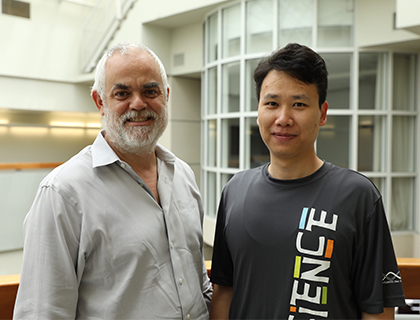TSRI Chemists Develop Inexpensive, Versatile Technique for Making RNA
By Jim Schnabel

Senior investigator Floyd E. Romesberg and first author Tingjian Chen.
Scientists at The Scripps Research Institute have developed a highly efficient new method for making ribonucleic acid (RNA) molecules in the laboratory. The method, described in the July 26 issue of the Journal of the American Chemical Society, works both for ordinary RNA and for several types of modified RNA. It has the potential to bring down dramatically the cost of producing RNA for scientific and pharmaceutical applications.
“Already three companies have contacted me about licensing this technology, so it’s not just a proof of principle—it’s going to be used,” said senior investigator Floyd E. Romesberg, a professor of chemistry at TSRI.
RNA’s close chemical cousin, DNA, can be synthesized efficiently and cheaply in the laboratory with a method called polymerase chain reaction (PCR), developed in 1983. Until now no comparable technique has been available for RNA—even though RNAs, especially short ones, are very much in demand in biological research and pharma development.
There are two conventional RNA-making methods. One uses organic chemistry reactions, and is very expensive and suited only for producing short RNA strands. The other conventional method employs a natural enzyme called an RNA polymerase to transcribe RNA strands from a starting strand of DNA. The polymerase-based method broadly mimics the transcription of RNA that occurs in cells; but in an artificial, test-tube environment it turns out to be very inefficient.
“With traditional test-tube transcription, the yields of RNAs are usually not high (compared to PCR of DNA), and for short RNAs they are even lower,” said study first author Tingjian Chen, a postdoctoral researcher in the Romesberg Laboratory
The new, much more efficient method emerged from a research effort centering on PCR, the DNA-amplification technique. PCR uses a DNA polymerase—of the type that cells use to replicate their DNA during cell-division—to make copies of a starting fragment of DNA. Because the copies and the starting fragments are all in DNA form and essentially identical, the products of each cycle of synthesis can serve as the starting templates for the next cycle. In a typical 15-30 cycle amplification, PCR can produce millions of copies of a DNA strand, starting from a tiny number of originals.
A few years ago, Chen sought to adapt PCR technology for use in amplifying so-called modified DNA. Like modified RNA, modified DNA has chemical changes that can make it useful as a scientific probe, for example, or even as a biologic drug.
In work described in a Nature Chemistry paper last year, Chen used test-tube-evolution techniques to develop an artificial DNA polymerase, SFM4-3, that can power the PCR amplification of a common type of modified DNA.
In that type of modified DNA, the modification exists at a site where DNA molecules differ chemically from RNA molecules. Therefore, Chen and Romesberg hypothesized that SFM4-3—despite originating as a DNA-synthesizing polymerase—might be tolerant enough of the differences between RNA and DNA that it could synthesize modified RNAs as well.
In the new study, that turned out to be the case. Chen discovered that SFM4-3 also works very well at producing ordinary RNA strands. Most importantly though, Chen found that the artificial polymerase can power a PCR-like chain reaction, resulting in an exponential production of RNAs.
The process, which Chen and Romesberg call polymerase chain transcription (PCT), is conceptually more complex than PCR. It involves the creation, and duplication in each cycle, of hybrid strands of DNA-plus-RNA, and the removal of the DNA with DNA-chopping enzymes at the end, leaving just the amplified RNA. But it also involves the same central chain-reaction principle in which the outputs of one cycle serve as inputs to the next. It thus yields a quantity of the desired RNA that can be at least several orders of magnitude greater than the quantity of DNA used as a starting template for transcription.
In a demonstration of the method’s practical potential, Chen used it to produce a modified RNA molecule that is being investigated as a possible anticoagulant therapy.
The new method should allow in some cases the production of modified RNAs that would be prohibitively expensive or even impossible to make using convention methods. Moreover, the new method should never be costly. As with PCR, the reagents the process consumes—strands of DNA, the polymerase, RNA building blocks—are all inexpensive and readily obtainable.
Chen estimated that with current RNA production methods (i.e. solid-phase chemical synthesis), the cost of making ordinary short RNAs is 10–20 times the cost of making short DNAs. The cost of making modified short RNAs is typically 100–200 times greater. The new method should close most of that RNA-DNA cost gap.
“I think this technique will be licensed, and it’ll eventually find its way into common use in labs where people need to prep RNA,” Romesberg said.
In the meantime, Chen and Romesberg plan to evolve the SFM4-3 polymerase further, to try to improve its efficiency, transcription accuracy and other properties.
“In our previous work evolving the SFM4-3 polymerase, we saw significant improvements in function with each round of evolution, so with more evolution I think we’ll see more improvement,” Chen said.
The research was supported by DARPA (Cooperative Agreement No. N66001-14-2-4052).
Send comments to: press[at]scripps.edu














